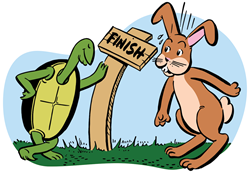

When I was much younger and started my career in the trucking industry, there was quite a bit of pride taken in trying to do what was perceived as the best job. It’s funny how your perception of what doing the best job qualifies as when you get older. When I started my trucking career, I worked in the food service industry. My goal was always to be able to make more deliveries than any of the other drivers could in the same amount of time.
Looking back, that was sort of a young and dumb thought process. Of course, as in almost any company, the more you accomplish, the more work (or in my case, deliveries) you are given. What’s funny is that while the safety department was stressing to us to slow down and be more cautious, the dispatchers kept me moving with as many loads as I could get delivered. Clearly, the safety director’s message and the sales/dispatch objectives were typically the total opposite.
What I remember from when I was younger in this industry, was arguing with the safety director. In my mind, they did not understand what needed to be accomplished during my normal daily routine. Like most drivers, I had much more contact with the sales and dispatch teams, than I did with the safety director. On any given day, it was easy to get drawn into being the hero by the sales and dispatch personnel. That team had a voracious appetite. No matter how much you accomplished, there was always more that could be done.
During this time, I had been involved in a few accidents. In each of those situations, I was found “not at fault” by the police. On every one of those occasions, the safety director drug me through the wringer and insisted that I could have avoided these crashes, had I allowed more time during my trips.
As I matured, I discovered that, indeed, the safety director was correct. When you’re driving a large truck, you will hear many people say, “You must run with traffic”. That’s not necessarily a good idea, because a large truck is not able to stop as quickly as many of the automobiles in its vicinity can. Also, when you put yourself out in the center lane, when three lanes are available, it puts you in a position where you are boxed in with no escape route, should there be a crash in any of the lanes next to, or in front, of your truck. This is where, when possible, the right lane - while not being the fastest lane, can often be the safest, because there is usually a wide shoulder to the right side of your vehicle as an escape route, should a vehicle be pushed into your lane in a crash or accident.
The final big observation that I have made over my trucking career, is that the very same people who considered and treated you as a hero for doing more than anyone else, will leave you high and dry if things go wrong, while you’re pursuing your “hero status”. No matter how much extra production you are able to put out, it will never make up for the cost that’s involved in the case of a collision. There are so many trial lawyers that are out there pursuing claims against the trucking industry, that we should all mind our P’s and Q’s to put an emphasis on safety over productivity. In the end, the safest and most cautious driver will often be the most productive and efficient driver, over the long haul.
I remember the childhood story that I, as well as many others, grew up with called “The Tortoise and the Hare”. The hare had speed, but in the end, the tortoise won the race. There are lessons to be learned from many of the stories from our childhood.